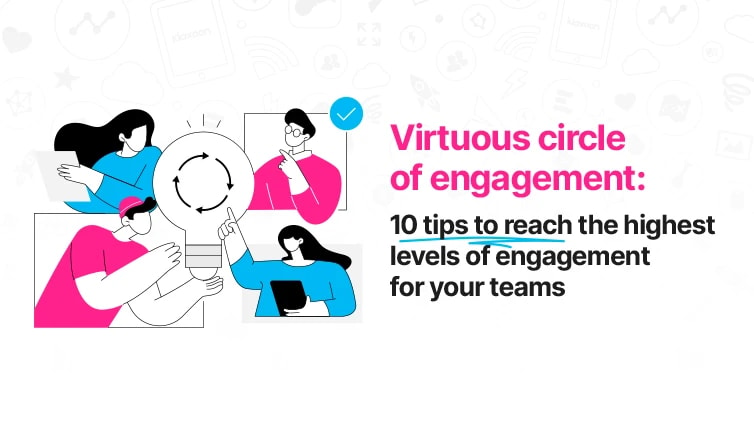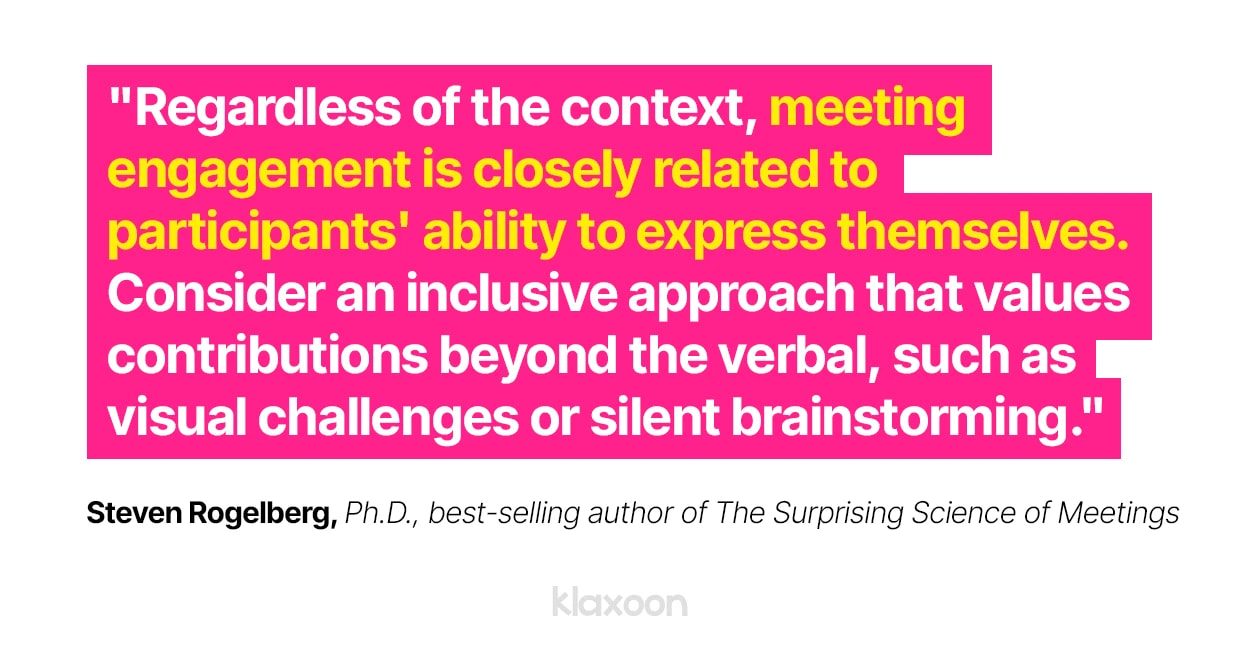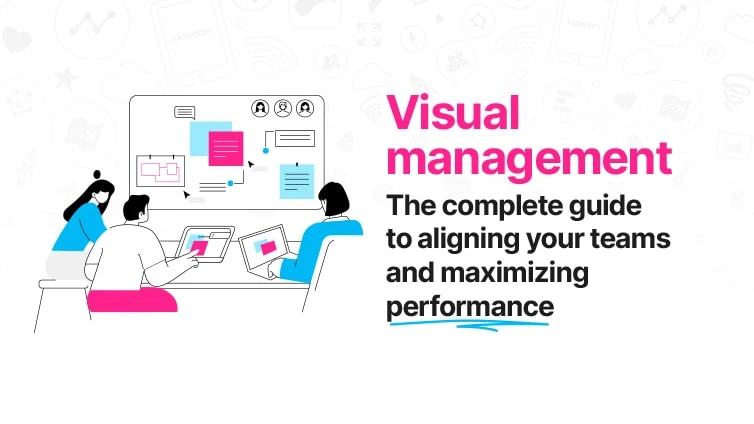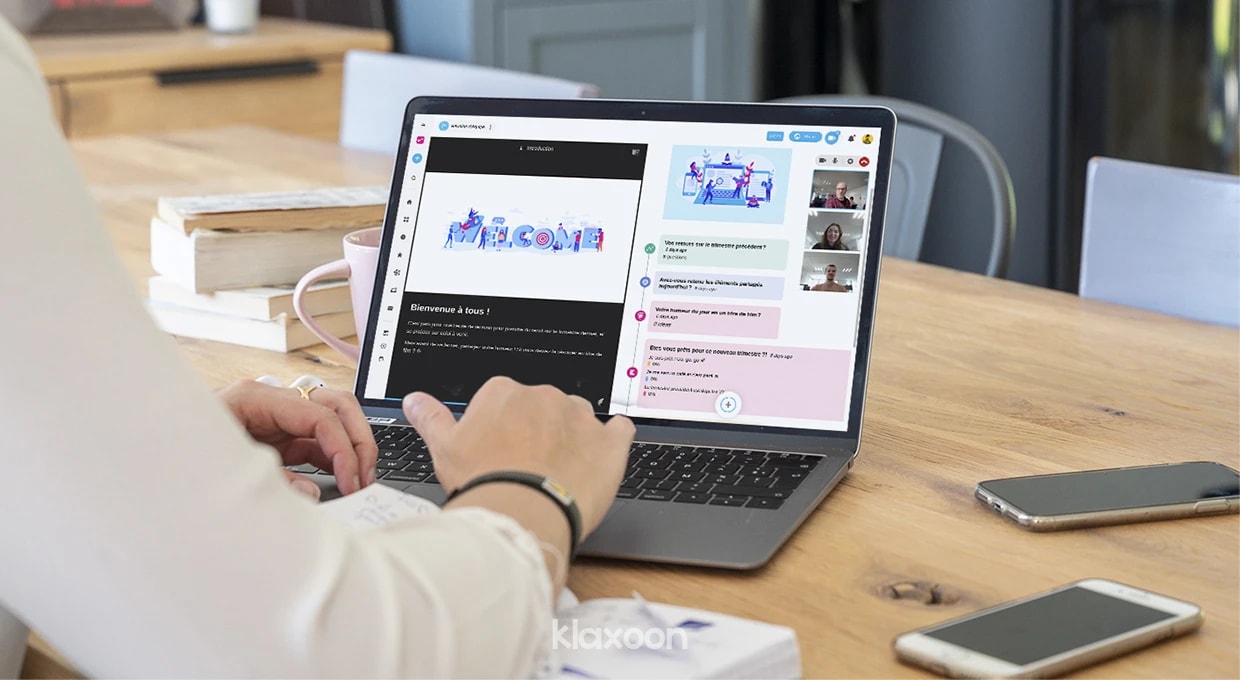The hidden costs of ineffective meetings: Challenges and strategies for maximizing collective performance
Published on July 30, 2025
The hidden costs of ineffective meetings: Challenges and strategies for maximizing collective performance
According to the Impactful Work 2024 report, companies lose an average of $15,000 per year per employee on duplicate tasks and inefficient meetings.
These meetings translate into visible costs (lost time, lower productivity, budgets), as well as hidden costs: frustration, disengagement, and inertia in decision-making. On average, an employee attends 8 meetings a week, and this figure doubles for senior executives. Against this backdrop, 80% of workers believe they would be more productive with fewer meetings.
To reduce the costs of meetings, rather than seeking to eliminate them altogether, you need to rethink their structure in depth. There are effective solutions to help you create a meeting space that offers your participants a fluid and engaging experience:
By deploying the full power of your collaborative workspace, your meetings become performance vectors, not obstacles. Participants are well-informed and actively involved, and the move to action comes naturally.

In 2024, the Impactful Work Report revealed that inefficiency costs companies an average of $15,000 per year per employee.
This notion of inefficiency encompasses both duplicate work and meetings that hinder productivity rather than boost it. The problem? These meetings generate numerous costs that impact team collaboration, the quality of ideas exchanged, engagement, and decision-making.
In this guide, you'll uncover both the visible and hidden costs of inefficient meetings that drain time, focus, and team energy. You'll also explore proven strategies to create meeting environments that keep participants engaged, focused, and empowered to make better decisions, during the meeting and long after it ends.


Participant engagement is a decisive factor in the effectiveness of a meeting, whether on-site or remotely.
Ineffective meetings can generate two types of costs:
Visible costs are those that an organization can easily recognize, such as lost time, reduced productivity, and direct financial expenses.
Conversely, hidden costs are costs that are often neglected by the organization, but whose impact is just as significant as that of visible costs. It is important to be able to identify them in your own meetings, as they normalize certain harmful behaviors which in turn lead to frustration, misunderstanding, and poor decision-making.
When you think of ineffective meetings, the first thing that springs to mind is the time you spend in them - the notorious "meetingitis". Many of us work to the rhythm of one meeting after another, especially those in the knowledge economy (which is essentially focused on the service sector).
On average, we attend 8 meetings a week, and this figure can double for senior executives. According to MIT, they can spend up to 23 hours a week in meetings - half their working time!
But are all these meetings essential? Not necessarily, since in many cases their content could be as simple as an email or an asynchronously shared document.
The second visible cost of inefficient meetings is productivity. Another impressive figure: no less than 80% of employees believe they would be more productive if they spent less time in meetings!
The reason is simple: it takes up their working time and prevents them from making progress on their other priorities. As a result, they have to find other moments to do it, including on their personal time.
This is how overtime and multitasking become the norm, with at least 92% of employees handling other tasks during meetings!
It is not uncommon to be checking e-mails or replying to colleagues via chat, while listening with a distracted ear to the meeting in progress. This has a double impact on productivity, both in terms of ancillary tasks and the meeting itself.
The impact of inefficient meetings is also directly reflected in your organization's budgets. To best estimate the financial cost of your meetings, several factors need to be taken into account:
Do you want to hold face-to-face meetings? If so, you will need to factor in logistical costs:
For this reason, many companies now prefer hybrid meetings, except when travel is necessary and justified. What's more, they are also increasingly mindful of their impact on the environment.
To enhance the hybrid meeting experience, meeting room equipment has also recently undergone significant evolution: video, interactive screens, connection speeds, etc. Whatever the context, a remote alternative must always be available to enable potential participants to join the meeting from anywhere.
Another important point is that the greater the number of people invited to the meeting, the higher the cost. This is because the participants are being asked to attend on their own time, so their individual remuneration must be taken into account.
This is a loss of revenue generated by the time spent in meetings. It is time that participants don't spend on activities that could contribute to the company's development. For example, a salesperson won't sell as long as he or she is taking part in in-house meetings. In the case of face-to-face meetings, the time spent traveling to the meeting site is not always worthwhile, either.
The result is that teams overstretched by ineffective meetings burn out, and are more exposed to long-term work overload.
According to Microsoft, 37% of workers at all hierarchical levels feel that their companies are asking too much of them today. These pressure levels can have a direct impact on their well-being at work, and lead to higher team turnover.
Less effective meetings also lead to a loss of overall engagement, which can translate into presenteeism. People go to meetings for the sake of going to meetings, while realizing that there is no real added value in being there. What's more, few participants dare refuse an invitation to a meeting for fear of being frowned upon, knowing full well that they will be more observers than real contributors.
Some people are therefore systematically favored over others in terms of their ability to express themselves and get involved in the meeting:
This leads to situations where only a few monopolize the speaking time, while the more introverted, remote participants or those who prefer to express themselves in writing, are left in the background. In the long run, this lack of commitment can generate a great deal of frustration.


Ineffective meetings that lack focus and clear objectives reduce the scope for action. Some participants multitask, others don't dare intervene, others are already looking ahead to their next meeting... The result is a succession of meetings leading to further meetings, with no real decision-making. As a result, more than half of all employees leave a meeting without a clear idea of the next steps to be taken.
Added to this is often the difficulty of finding a common slot for all participants to organize the next meeting, as their agendas are already full. Decisions (if they are made at all) are themselves ultimately delayed, as meetings are constantly being rescheduled.
Ultimately, inefficient meetings have a negative impact on the quality of collaboration and relationships between team members. This creates communication silos between teams, which become disengaged and inward-looking, preventing the full potential of cross-functional collaboration from being realized.
While meeting organizers are increasingly aware of the importance of good upstream preparation, this can sometimes be skewed by a lack of visibility of participants' expectations. Without a structured survey to gather their needs and assess their level of familiarity with the subject, the ensuing meeting content risks becoming top-down and difficult to digest.


Understanding participants' needs and their level of familiarity with the subject at hand can greatly simplify the running of your meeting.
One of the reasons given by companies for wanting their teams to return to 100% face-to-face meetings is that it is a way of meeting informally and exchanging ideas more easily than by organizing meetings. However, it can also lead to the opposite excess of improvising meetings and stretching out exchange times, despite everyone's schedules.
Furthermore, switching back to in-person meetings does not mean the end of video conferencing. HBR shows that many companies continue to use online meeting tools even when they are on site because they see two main advantages:
On the other hand, spending the whole day holding one videoconference meeting after another is not a sustainable solution either. It causes cognitive fatigue in participants, reducing their concentration and productivity, and making them more passive in meetings. In fact, more than 1 in 3 employees today consider "Zoom fatigue" to be the biggest problem associated with virtual meetings.
Where possible, videoconferencing should therefore be seen as a complementary tool to face-to-face interaction, not a complete substitute for it.
If meetings have such negative impacts, why do we continue holding them? This question has already been posed, and many companies have recently experimented with eliminating meetings altogether. Two key observations emerged from these trials:
This shows that the real problem lies not in the nature of meetings, but in a lack of structure that renders them ineffective.

From the preparation phase through to decision-making, structuring your meetings properly is fundamental to reducing all the costs listed above, and organizing productive, performance-boosting meetings.
If the problem of inefficient meetings has persisted for so long in companies, it is because the effort required is deemed too great to transform their meeting practices at root.
For example, Amazon has radically transformed the structure of its meetings by implementing a comprehensive system focused on autonomy and accountability. This system includes controlling the number of participants, with the principle of "2-Pizza teams", i.e. a maximum of as many guests as it takes to eat 2 pizzas without going hungry (generally 7 to 8 guests). In addition, at the start of the meeting, a 6-page memo is distributed to participants to inform them of the context and objectives. Although this step, carried out independently, can be relatively laborious, it proves to be highly effective when used in conjunction with the other practices deployed by the American e-commerce giant.
This example demonstrates that to truly transform the structure of your meetings, the first step is to establish a comprehensive and flexible meeting space for your teams. It should centralize all communications, seamlessly support both hybrid and in-person work, and consistently engage participants in a meaningful way.
For example, you can create such a space using Klaxoon's all-in-one collaborative platform. Accessible anytime and from anywhere, it boosts the efficiency of your exchanges in meetings and beyond, and lets everyone express themselves in the way that suits them best. What's more, its collaborative tools ensure continuity in the follow-up to your meetings, centralizing all important information in one place, and saving time in creating minutes.
Klaxoon also integrates with Wrike’s work management platform. With features such as collaborative task tracking, shared dashboards, and real-time document editing, Wrike helps transform meeting decisions into concrete actions with clearly defined responsibilities and deadlines.
Now, let's take a look at the best ways for you to harness the full power of your collaborative workspace to better structure your meetings, and turn them into real opportunities to unleash the potential of the collective.
Flexibility is essential for employees to be effective in meetings. Your workspace must seamlessly adapt to both in-person and remote work, eliminating the time and friction typically required to switch contexts or devices.
With Klaxoon, a Board or a Session lets you create a meeting space with an integrated videoconferencing tool, enabling participants to join the exchanges from anywhere, and from any connected device (computer, smartphone or tablet).


In a Session, the organizer can propose several Klaxoon activities to meeting participants, to be carried out together in a pre-defined order.
Furthermore, thanks to the integration between Wrike and Klaxoon, you can convert your ideas from Klaxoon Boards into tasks or items in Wrike, combining the power of both platforms. This saves valuable time and reduces errors during meetings, resulting in immediate action.
We have already talked about the importance of preparing your meetings properly, without forgetting to take into account the expectations of all participants. Today, lack of preparation is still cited as the primary cause of ineffective meetings, by more than 1 in 4 employees.
There are many ways in which you can improve this preparation stage:
From the start, make sure to highlight the expected outcomes of the meeting and clearly outline the resources or methods you believe will help achieve those goals together.
At this stage, you may also realize that the best way to achieve the desired result is simply not to hold a meeting. In this case, you can share information and exchange with your team asynchronously, while setting a deadline for submitting your ideas.
It has been shown that for the majority of routine meetings, the subject to be dealt with can be tackled with maximum efficiency in just 30 minutes. Don't hesitate to use a timer to keep time under control, and to focus each of your meetings on a key topic. You can also use the ROTI (Return on Time Invested) method available on the Klaxoon platform to evaluate the return on investment of your meetings and improve.
Find ways to maximize the engagement of all the personalities present in your meeting, whether extroverted or introverted, whether interacting orally or in writing.
To help you do this, Klaxoon makes this stage considerably easier by generating engagement before, during and after your meetings:
To save even more time, centralize your exchanges in a single space that will remain accessible to participants at all times. You no longer need to manually transcribe your meetings, and if you can automatically generate minutes and export them with a single click, that is even better!
With Klaxoon, you can do just that from a Session or a Board. You can also export the essential takeaways from your meetings in a Memo, and share them with participants afterwards.


In just a few structured pages, all participants have a clear vision of the outcome of the meeting with Memo.
Constantly evaluate the effectiveness of your meetings by subjecting them to regular audits, gathering feedback from your participants and making any necessary adjustments for subsequent meetings. This process is particularly effective for recurring meetings (weekly, monthly, etc.).
Are you short of time to implement these actions? There are many recognized meeting management methodologies to help you rapidly improve the structure and organization of your meetings. We have already come across some of them in this guide.
The good news is that Klaxoon has a library of ready-to-use templates based on all these methodologies:
With these templates, your collaborative space is already structured to help you be more efficient and save precious time, and all you have to do is add your information for cost-effective meetings!
Unlock your teamwork potential